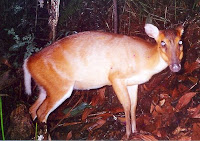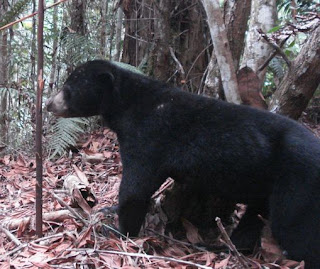16 November 2008
The Remote Hunting-Camera (Overview)
Movement of a heat-radiating animal across the field of the sensor triggers a silent electronic switch that engages the camera to take a photograph. For obtaining clear photographs, 24 exposures of ASA 400 FUJI color print film will be used and a time and date will be recorded for each exposure. Deercam units have a delay selector mechanism that precludes the camera from taking a photograph for a set period of time (in our case 1 minute), which reduces wastage of film. All cameras will be operational 24 hours a day. All cameras will be marked by using GPS (Global Positioning System) and plotted in a map using GIS system. Camera will be checked in every 14 days after the setup, and will be removed two weeks later for film development.
What We Had Revealed??
 Paguma larvata, the Masked Palm Civet, one of the forest-dependent species that feeding mostly on fruits. One of the target species by local hunter for food. Rarely enter garden and plantation. Only photographed once in disturbed forest adjacent to monoculture plantation in Sarawak.
Paguma larvata, the Masked Palm Civet, one of the forest-dependent species that feeding mostly on fruits. One of the target species by local hunter for food. Rarely enter garden and plantation. Only photographed once in disturbed forest adjacent to monoculture plantation in Sarawak. Arctictis binturong, the so-called bearcat is one of the most difficult viverrids species detected by hunting-camera due to their aboreal behavior. Sometimes can be mistaken with young bear. Aggressive and a very good climber.
Arctictis binturong, the so-called bearcat is one of the most difficult viverrids species detected by hunting-camera due to their aboreal behavior. Sometimes can be mistaken with young bear. Aggressive and a very good climber. Viverra tangalunga, the Malay Civet is one of nine civet species inhabits various habitat types in Sarawak. Completely terrestrial and feeding on invertebrates and small vertebrates on forest floor. The most common civets photographed by hunting-camera.
Viverra tangalunga, the Malay Civet is one of nine civet species inhabits various habitat types in Sarawak. Completely terrestrial and feeding on invertebrates and small vertebrates on forest floor. The most common civets photographed by hunting-camera. Muntiacus atherodes, the Bornean Yellow Muntjac is the only muntjac species endemic to the island of Borneo. This species is inhabits lowland habitat of tropical rainforest in Sarawak.
Muntiacus atherodes, the Bornean Yellow Muntjac is the only muntjac species endemic to the island of Borneo. This species is inhabits lowland habitat of tropical rainforest in Sarawak. Macaca fascicularis, the Long-tailed Macaque, rarely descending to the ground, which make it difficult to photograph with wildlife-hunting camera.
Macaca fascicularis, the Long-tailed Macaque, rarely descending to the ground, which make it difficult to photograph with wildlife-hunting camera. Macaca nemestrina, the Pig-tailed Macaque. 70 percent of the camera trap photos taken are of this species. In Sarawak, they are called nyumboh (Iban word) and are extremely common in disturbed habitats.
Macaca nemestrina, the Pig-tailed Macaque. 70 percent of the camera trap photos taken are of this species. In Sarawak, they are called nyumboh (Iban word) and are extremely common in disturbed habitats.  Sus barbatus, the Bearded Pig one of the most frequent animals photographed by remote camera. They are also the only species from the family of Suidae found in the forest of Sarawak.
Sus barbatus, the Bearded Pig one of the most frequent animals photographed by remote camera. They are also the only species from the family of Suidae found in the forest of Sarawak.  Helarctos malayanus locally known as Bornean Sunbear or beruang madu is the only species of bear inhabit tropical rainforest of Sarawak and Borneo generally.
Helarctos malayanus locally known as Bornean Sunbear or beruang madu is the only species of bear inhabit tropical rainforest of Sarawak and Borneo generally. Voice of The Conservationist
Wildlife Remote Camera, Sarawak 2008
to be continued.... (Chiropterans of the Two Caves in Bintulu, Sarawak)
Subscribe to:
Posts (Atom)
